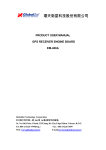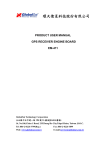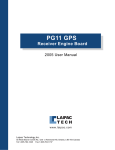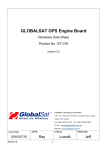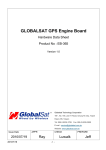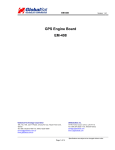Download PRODUCT USER MANUAL GPS ENGINE BOARD ET-314
Transcript
PRODUCT USER MANUAL GPS ENGINE BOARD ET-314 Features: SiRF starⅢ high performance GPS Chip Set Very high sensitivity (Tracking Sensitivity: -159 dBm) Extremely fast TTFF (Time To First Fix) at low signal level Compact size (25.4mm * 25.4 mm * 3.3mm) suitable for space-sensitive application One size component, easy to mount on another PCB board Support NMEA 0183 and SiRF binary protocol Specification: General Chipset SiRF StarⅢ Frequency C/A code Channels Sensitivity L1, 1575.42 MHz 1.023 MHz chip rate 20 channel all-in-view tracking -159 dBm Accuracy Position Velocity Time 10 meters, 2D RMS 5 meters, 2D RMS, WAAS enabled 0.1 m/s 1us synchronized to GPS time Datum Default WGS-84 Acquisition Time Reacquisition Hot start Warm start Cold start 0.1 sec., average 1 sec., average 38 sec., average 42 sec., average Dynamic Conditions Altitude Velocity Acceleration Jerk 18,000 meters (60,000 feet) max 515 meters /second (1000 knots) max Less than 4g 20m/sec **3 Power Main power input Power consumption Interface Dimension Baud rate Output message 3.3V +- 5% DC input 68mA (Continuous mode) 25.4mm * 25.4 mm * 3.3mm 4,800 to 57,600 bps adjustable SiRF binary or NMEA 0183 GGA, GSA, GSV, RMC, VTG, GLL GPS Antenna Specification(Recommendation) Frequency: 1575.42+2 MHz Axial Ratio: 3 dB Typical output Impedance: 50Ω Polarization: RHCP Amplifier Gain :20~26dB Typical Output VSWR: 2.0 Max. Noise Figure: 2.0 dB Max. Environmental Operating Temp -40℃ to +85℃ Pin Assignment Pin Signal Name I/O Description 1 VCC I DC Supply Voltage input 2 3 GND Boot select G I Ground Boot mode 4 RXA I Serial port A 5 TXA O Serial port A 6 TXB O Serial port B 7 RXB I Serial port B 8 GPIO14 I/O General –purpose I/O 9 RF_ON 10 GND G Digital Ground 11 16 GND_A G Analog Ground 17 18 RF_IN GND_A I G GPS Signal input Analog Ground 19 V_ANT_IN I Active Antenna Bias voltage 20 VCC_RF O Supply Antenna Bias voltage 21 V_BAT I Backup voltage supply 22 Reset I Reset (Active low) 23 GPIO10 I/O General purpose I/O 24 GPIO1 I/O General purpose I/O 25 GPIO5 I/O General purpose I/O 26 GPIO0 I/O General purpose I/O (support continuous power mode only) 27 GPIO13 I/O General purpose I/O 28 GPIO15 I/O General purpose I/O 29 PPS O One pulse per second 30 GND G Digital Ground Definition of Pin assignment VCC This is the main DC supply for a 3.3V +- 5% DC input power module board. GND GND provides the ground for digital part. Boot select Set this pin to high for programming flash. RXA This is the main receiver channel and is used to receive software commands to the board from SIRFdemo software or from user written software. PS: Pull up if not used. RXB This is the auxiliary receiving channel and is used to input differential corrections to the board to enable DGPS navigation. PS: Pull up if not used. TXA This is the main transmitting channel and is used to output navigation and measurement data to SiRFdemo or user written software. TXB For user’s application (not currently used). RF_ON This pin indicates state of RF voltage. RF_IN This pin receiver signal of GPS analog .due to the RF characteristics of the signal the design has to certain criteria. The line on the PCB from the antenna(or antenna connector) has to be a controlled microstrip line at 50Ω V_ANT_IN This pin is reserved an external DC power supply for active antenna. If using 3.0V active antenna, pin 19 has to be connected to pin 20. If using 3.3V or 12V active antenna, this pin has to be connected to 3.3V or 5V power supply. VCC_RF This pin provides DC voltage 3.0 for active antenna. Reset This pin provides an active-low reset input to the board. It causes the board to reset and start searching for satellites. If not utilized, it may be left open. PPS This pin provides one pulse-per-second output from the board, which is synchronized to GPS time. This is not available in Trickle Power mode. Backup battery (V_BAT) This is the battery backup input that powers the SRAM and RTC when main power is removed. Typical current draw is 15uA. Without an external backup battery, the module/engine board will execute a cold star after every turn on. To achieve the faster start-up offered by a hot or warm start, a battery backup must be connected. The battery voltage should be between 2.0v and 5.0v. Without an external backup battery or super cap, the TMP will execute a cold start after every power on. To achieve the faster start-up offered by a hot or warm start, either a battery backup must be connected or a super cap installed. To maximize battery lifetime, the battery voltage should not exceed the supply voltage and should be between 2.5V and 3.6V. With the super cap (B1) installed, and after at least ten minutes of continuous operation, the data retention is about seven hours. Note that even though all other components are rated at –30 to +85 deg C, a typical super cap is specified over a temperature range of –25 to +70 deg C and a typical rechargeable Lithium battery is over –20 to +70 deg C. GPIO Functions Several I/Os are connected to the digital interface connector for custom applications. Application Circuit 2 R4 10k 10k 1 R3 10k 1 R2 10k U1 1 2 3 RXA 4 TXA 5 TXB 6 RXB 7 GPIO_14 8 9 10 11 12 13 14 15 GPS VCC GND GND 1PPS Bootselect GPIO_15 RXA GPIO_13 TXA GPIO_0 TXB GPIO_5 RXB GPIO_14 RF_ON GND GPIO_1 GPIO_10 NRESET V_BAT A_GND VCC_RF A_GND V_ANT A_GND A_GND A_GND RF_IN A_GND A_GND 30 29 1PPS 28 GPIO_15 27 GPIO_13 26 GPIO_0 25 GPIO_5 24 GPIO_1 23 GPIO_10 22 RESET 21 V_BAT 20 VCC_RF 19 V_ANT 18 17 50 ohm microstrip line 2 ACTIVE ANT 16 1 2 2 R1 1 1 2 VCC (1) Ground Planes: ET-314 GPS receiver needs two different ground planes. The GND_A pin(11、 12、13、14、15、16、18) shall be connect to analog ground. The GND pin(2、10、30) connect to digital ground. (2) Serial Interface: The Serial interface pin(RXA、TX1、TXB、RXB) is recommended to pull up(10KΩ). It can increase the stability of serial data. (3) Backup Battery: It’s recommended to connect a backup battery to V_BAT. In order to enable the warm and hot start features of the GPS receiver. If you don’t intend to use a backup battery, connect this pin to GND or open. If you use backup battery, shall need to add a bypassing capacitor (10uF) at V_bat trace. It can reduce noise and increase the stability. (4) Antenna: Connecting to the antenna has to be routed on the PCB. The transmission line must to controlled impedance to connect RF_IN to the antenna or antenna connector of your choice. (5) Active antenna bias voltage: The Vcc_RF pin (pin 20) is providing voltage 3.3V. If you use active antenna, you can connect this pin to V_ANT_IN pin (pin 19) to provide bias voltage of active Recommend Layout PAD Mechanical Layout SOFTWARE COMMAND NMEA Output Command GGA-Global Positioning System Fixed Data Table B-2 contains the values for the following example: $GPGGA,161229.487,3723.2475,N,12158.3416,W,1,07,1.0,9.0,M,,,,0000*18 Table B-2 GGA Data Format Name Example Message ID UTC Time Latitude N/S Indicator Longitude E/W Indicator Position Fix Indicator Satellites Used HDOP MSL Altitude1 Units Geoid Separation1 Units Age of Diff. Corr. Diff. Ref. Station ID Checksum <CR><LF> $GPGGA 161229.487 3723.2475 N 12158.3416 W 1 07 1.0 9.0 M M Units Description GGA protocol header hhmmss.sss ddmm.mmmm N=north or S=south dddmm.mmmm E=east or W=west See Table B-3 Range 0 to 12 Horizontal Dilution of Precision meters meters meters meters second Null fields when DGPS is not used 0000 *18 End of message termination SiRF Technology Inc. does not support geoid corrections. Values are WGS84 ellipsoid heights. Table B-3 Position Fix Indicator Value Description 0 Fix not available or invalid 1 GPS SPS Mode, fix valid 2 Differential GPS, SPS Mode , fix valid 3 GPS PPS Mode, fix valid GLL-Geographic Position-Latitude/Longitude Table B-4 contains the values for the following example: $GPGLL,3723.2475,N,12158.3416,W,161229.487,A*2C Table B-4 GLL Data Format Name Message ID Latitude N/S Indicator Longitude E/W Indicator UTC Position Status Checksum <CR><LF> Example $GPGLL 3723.2475 n 12158.3416 W 161229.487 A *2C Units Description GLL protocol header ddmm.mmmm N=north or S=south dddmm.mmmm E=east or W=west hhmmss.sss A=data valid or V=data not valid End of message termination GSA-GNSS DOP and Active Satellites Table B-5 contains the values for the following example: $GPGSA,A,3,07,02,26,27,09,04,15,,,,,,1.8,1.0,1.5*33 Table B-5 GSA Data Format Name Message ID Mode1 Mode2 Satellite Used1 Satellite Used1 ….. Satellite Used1 PDOP HDOP VDOP Checksum <CR><LF> Example $GPGSA A 3 07 02 Units Description GSA protocol header See Table B-6 See Table B-7 Sv on Channel 1 Sv on Channel 2 Sv on Channel 12 Position dilution of Precision Horizontal dilution of Precision Vertical dilution of Precision 1.8 1.0 1.5 *33 1. End of message termination Satellite used in solution. Table B-6 Mode1 Value M A Description Manual-forced to operate in 2D or 3D mode 2Dautomatic-allowed to automatically switch 2D/3D Table B-7 Mode 2 Value 1 2 3 Description Fix Not Available 2D 3D GSV-GNSS Satellites in View Table B-8 contains the values for the following example: $GPGSV,2,1,07,07,79,048,42,02,51,062,43,26,36,256,42,27,27,138,42*71 $GPGSV,2,2,07,09,23,313,42,04,19,159,41,15,12,041,42*41 Table B-8 GSV Data Format Name Message ID Number of Messages1 Message Number1 Satellites in View Satellite ID Elevation Azimuth SNR(C/No) ……. Satellite ID Elevation Azimuth SNR(C/No) Checksum <CR><LF> Example $GPGSV 2 1 07 07 79 048 42 27 27 138 42 *71 Description GSV protocol header Range 1 to 3 Range 1 to 3 degrees degrees dBHz Degrees Degrees dBHz Channel 1(Range 1 to 32) Channel 1(Maximum90) Channel 1(True, Range 0 to 359) Range 0 to 99,null when not tracking ……. Channel 4 (Range 1 to 32) Channel 4(Maximum90) Channel 4(True, Range 0 to 359) Range 0 to 99,null when not tracking End of message termination Depending on the number of satellites tracked multiple messages of GSV data may be required. RMC-Recommended Minimum Specific GNSS Data Table B-10 contains the values for the following example: $GPRMC,161229.487,A,3723.2475,N,12158.3416,W,0.13,309.62,120598,,*10 Table B-10 RMC Data Format Name Example Units Description Message ID $GPRMC RMC protocol header UTC Time 161229.487 hhmmss.sss Status A A=data valid or V=data not valid Latitude 3723.2475 ddmm.mmmm N/S Indicator N N=north or S=south Longitude 12158.3416 dddmm.mmmm E/W Indicator W E=east or W=west Speed Over Ground 0.13 knots Course Over Ground 309.62 degrees True Date 120598 ddmmyy Magnetic Variation2 degrees E=east or W=west Checksum *10 <CR><LF> End of message termination SiRF Technology Inc. does not support magnetic declination. All “course over ground” data are geodetic WGS48 directions. VTG-Course Over Ground and Ground Speed $GPVTG,309.62,T,,M,0.13,N,0.2,K*6E Name Message ID Course Reference Course Reference Speed Units Speed Units Checksum <CR><LF> Example $GPVTG 309.62 T Units degrees degrees M 0.13 N 0.2 K *6E knots Km/hr Description VTG protocol header Measured heading True Measured heading Magnetic Measured horizontal speed Knots Measured horizontal speed Kilometers per hour End of message termination 2.2 NMEA Input Command A). Set Serial Port ID:100 Set PORTA parameters and protocol This command message is used to set the protocol(SiRF Binary, NMEA, or USER1) and/or the communication parameters(baud, data bits, stop bits, parity). Generally,this command would be used to switch the module back to SiRF Binary protocol mode where a more extensive command message set is available. For example,to change navigation parameters. When a valid message is received,the parameters will be stored in battery backed SRAM and then the receiver will restart using the saved parameters. Format: $PSRF100,<protocol>,<baud>,<DataBits>,<StopBits>,<Parity>*CKSUM <CR><LF> <protocol> <baud> <DataBits> <StopBits> <Parity> 0=SiRF Binary, 1=NMEA, 4=USER1 1200, 2400, 4800, 9600, 19200, 38400 8,7. Note that SiRF protocol is only valid f8 Data bits 0,1 0=None, 1=Odd, 2=Even Example 1: Switch to SiRF Binary protocol at 9600,8,N,1 $PSRF100,0,9600,8,1,0*0C<CR><LF> Example 2: Switch to User1 protocol at 38400,8,N,1 $PSRF100,4,38400,8,1,0*38<CR><LF> **Checksum Field: The absolute value calculated by exclusive-OR the 8 data bits of each character in the Sentence,between, but excluding “$” and “*”. The hexadecimal value of the most significant and least significant 4 bits of the result are convertted to two ASCII characters (0-9,A-F) for transmission. The most significant character is transmitted first. **<CR><LF> : Hex 0D 0A B). Navigation lnitialization ID:101 Parameters required for start This command is used to initialize the module for a warm start, by providing current position (in X, Y, Z coordinates),clock offset, and time. This enables the receiver to search for the correct satellite signals at the correct signal parameters. Correct initialization parameters will enable the receiver to acquire signals more quickly, and thus, produce a faster navigational solution. When a valid Navigation Initialization command is received, the receiver will restart using the input parameters as a basis for satellite selection and acquisition. Format: $PSRF101,<X>,<Y>,<Z>,<ClkOffset>,<TimeOfWeek>,<WeekNo>,<chnlCount>,<R esetCfg> *CKSUM<CR><LF> <X> <Y> <Z> <ClkOffset> <TimeOf Week> <WeekNo> <chnlCount> X coordinate position INT32 Y coordinate position INT32 Z coordinate position INT32 Clock offset of the receiver in Hz, Use 0 for last saved value if available. If this is unavailable, a default value of 75000 for GSP1, 95000 for GSP 1/LX will be used. INT32 GPS Time Of Week UINT32 GPS Week Number UINT16 ( Week No and Time Of Week calculation from UTC time) Number of channels to use.1-12. If your CPU throughput is not high enough, you could decrease needed throughput by reducing the number of active channels UBYTE <ResetCfg> bit mask 0×01=Data Valid warm/hotstarts=1 0×02=clear ephemeris warm start=1 0×04=clear memory. Cold start=1 UBYTE Example: Start using known position and time. $PSRF101,-2686700,-4304200,3851624,96000,497260,921,12,3*7F C). Set DGPS Port ID:102 Set PORT B parameters for DGPS input This command is used to control Serial Port B that is an input only serial port used to receive RTCM differential corrections. Differential receivers may output corrections using different communication parameters. The default communication parameters for PORT B are 9600 Baud, 8data bits, 0 stop bits, and no parity. If a DGPS receiver is used which has different communication parameters, use this command to allow the receiver to correctly decode the data. When a valid message is received, the parameters will be stored in battery backed SRAM and then the receiver will restart using the saved parameters. Format: $PSRF102,<Baud>,<DataBits>,<StopBits>,<Parity>*CKSUM<CR><LF> <baud> <DataBits> <StopBits> <Parity> 1200,2400,4800,9600,19200,38400 8 0,1 0=None,Odd=1,Even=2 Example: Set DGPS Port to be 9600,8,N,1 $PSRF102,9600,8,1.0*12 D). Query/Rate Control ID:103 Query standard NMEA message and/or set output rate This command is used to control the output of standard NMEA message GGA, GLL, GSA, GSV RMC, VTG. Using this command message, standard NMEA message may be polled once, or setup for periodic output. Checksums may also be enabled or disabled depending on the needs of the receiving program. NMEA message settings are saved in battery backed memory for each entry when the message is accepted. Format: $PSRF103,<msg>,<mode>,<rate>,<cksumEnable>*CKSUM<CR><LF> <msg> 0=GGA,1=GLL,2=GSA,3=GSV,4=RMC,5=VTG <mode> 0=SetRate,1=Query <rate> Output every <rate>seconds, off=0,max=255 <cksumEnable> 0=disable Checksum,1=Enable checksum for specified message Example 1: Query the GGA message with checksum enabled $PSRF103,00,01,00,01*25 Example 2: Enable VTG message for a 1Hz constant output with checksum enabled $PSRF103,05,00,01,01*20 Example 3: Disable VTG message $PSRF103,05,00,00,01*21 E). LLA Navigation lnitialization using Lat/Lon/Alt ID:104 Parameters required to start This command is used to initialize the module for a warm start, by providing current position (in Latitude, Longitude, Altitude coordinates), clock offset, and time. This enables the receiver to search for the correct satellite signals at the correct signal parameters. Correct initialization parameters will enable the receiver to acquire signals more quickly, and thus, will produce a faster navigational soution. When a valid LLANavigationInitialization command is received,the receiver will restart using the input parameters as a basis for satellite selection and acquisition. Format: $PSRF104,<Lat>,<Lon>,<Alt>,<ClkOffset>,<TimeOfWeek>,<WeekNo>, <ChannelCount>, <ResetCfg>*CKSUM<CR><LF> <Lat> Latitude position, assumed positive north of equator and negative south of equator float, possibly signed <Lon> Longitude position, it is assumed positive east of Greenwich and negative west of Greenwich Float, possibly signed <Alt> Altitude position float, possibly signed <ClkOffset> Clock Offset of the receiver in Hz, use 0 for last saved value if available. If this is unavailable, a default value of 75000 for GSP1, 95000 for GSP1/LX will be used. INT32 <TimeOfWeek> GPS Time Of Week UINT32 <WeekNo> GPS Week Number UINT16 <ChannelCount> Number of channels to use. 1-12 UBYTE <ResetCfg> bit mask 0×01=Data Valid warm/hot starts=1 0×02=clear ephemeris warm start=1 0×04=clear memory. Cold start=1 UBYTE Example: Start using known position and time. $PSRF104,37.3875111,-121.97232,0,96000,237759,922,12,3*37 F). Development Data On/Off Messages On/Off ID:105 Switch Development Data Use this command to enable development debug information if you are having trouble getting commands accepted. Invalid commands will generate debug information that should enable the user to determine the source of the command rejection. Common reasons for input command rejection are invalid checksum or parameter out of specified range. This setting is not preserved across a module reset. Format: $PSRF105,<debug>*CKSUM<CR><LF> <debug> 0=Off,1=On Example: Debug On Example: Debug Off G). Select Datum Transformations ID:106 $PSRF105,1*3E $PSRF105,0*3F Selection of datum to be used for coordinate GPS receivers perform initial position and velocity calculations using an earth-centered earth-fixed (ECEF) coordinate system. Results may be converted to an earth model (geoid) defined by the selected datum. The default datum is WGS 84 (World Geodetic System 1984) which provides a worldwide common grid system that may be translated into local coordinate systems or map datums. (Local map datums are a best fit to the local shape of the earth and not valid worldwide.) Examples: Datum select TOKYO_MEAN $PSRF106,178*32






















